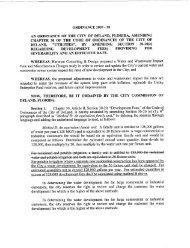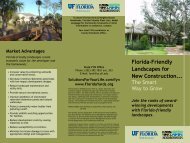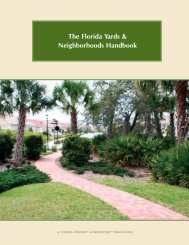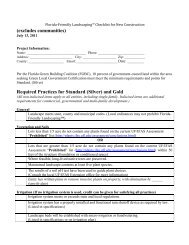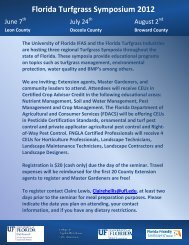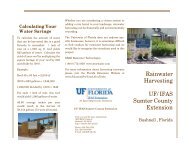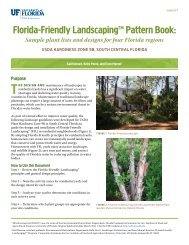A Guide to Florida-Friendly Landscaping A Guide to Florida-Fr ...
A Guide to Florida-Friendly Landscaping A Guide to Florida-Fr ...
A Guide to Florida-Friendly Landscaping A Guide to Florida-Fr ...
You also want an ePaper? Increase the reach of your titles
YUMPU automatically turns print PDFs into web optimized ePapers that Google loves.
Seasonal Ponds<br />
A common pond type — and perhaps the easiest <strong>to</strong> imitate as a yard feature —<br />
is a shallow “seasonal” pond, typically 2'–5' deep and 25'–150' across. Variations<br />
in seasonal rainfall cause fluctuations in water level, appearance and function.<br />
In winter, standing water recedes, often drying down completely, depending on<br />
the pond’s water depth, soil type and the local water table. But even in this<br />
“dry-down” condition, a seasonal pond offers moisture sources, the damp<br />
habitats required by many amphibians, reptiles, birds and small mammals.<br />
If you wish <strong>to</strong> construct a pond <strong>to</strong> replicate these important<br />
habitats, choose an area that:<br />
■<br />
■<br />
■<br />
accommodates the shallow and wide profile<br />
already contains suitable plant life and soil types<br />
provides access for wildlife<br />
Conclusions: Connecting Our Yards<br />
<strong>to</strong> <strong>Florida</strong>'s Waterways<br />
The future of <strong>Florida</strong>’s treasured water resources begins in your yard. The<br />
decisions you make — from developing a home site, <strong>to</strong> landscaping your yard,<br />
<strong>to</strong> fertilizing your lawn — actually influence the health of <strong>Florida</strong>’s natural<br />
waterways. Nature doesn’t recognize property lines. A rains<strong>to</strong>rm can wash bare<br />
soil, landscape debris, gas, oil, fertilizers or pesticides from one yard <strong>to</strong> another.<br />
A butterfly attracted <strong>to</strong> one person’s wildflowers can flit across a property line<br />
in<strong>to</strong> another landscape. Landscapes do not just connect people <strong>to</strong> the<br />
outdoors; they also connect one person’s property <strong>to</strong> the next, forming<br />
neighborhoods. Ultimately, yards and neighborhoods are connected <strong>to</strong> water<br />
resources. This connection may be immediate, as in a waterfront community, or<br />
gradual, through the flow of s<strong>to</strong>rm drains, ditches, streams, rivers and ground<br />
water.<br />
For more information on <strong>Florida</strong>-friendly landscaping, contact the FYN<br />
Coordina<strong>to</strong>r at your county's UF/IFAS Extension office (find contact information<br />
at http://solutionsforyourlife.ufl.edu) or visit the state FYN website at http://<br />
fyn.ifas.ufl.edu.<br />
EPA, Locate Your Watershed:<br />
http://cfpub.epa.gov/surf/locate/<br />
104



